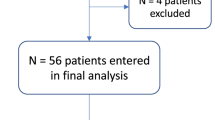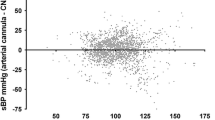Abstract
The innovative vascular unloading technology (VUT) allows continuous noninvasive arterial blood pressure (AP) monitoring. We aimed to investigate whether the VUT enables AP changes to be detected earlier compared with intermittent AP monitoring in patients undergoing gastrointestinal endoscopy. In this prospective observational study, we recorded continuous AP measurements with the VUT (CNAP system; CNSystems Medizintechnik AG, Graz, Austria) and intermittent AP measurements with upper arm cuff oscillometry in 90 patients undergoing complex gastrointestinal endoscopy (Department of Interventional Endoscopy at the University Medical Center Hamburg-Eppendorf, Hamburg, Germany). A “hypotensive phase” was defined as a time period of at least 30 s during which ≥ 50% of the VUT-AP values were in a predefined range of hypotension, i.e., AP value a) ≥ 10% below the last oscillometric value and b) ≤ 65 mmHg for mean AP or ≤ 90 mmHg for systolic AP. In the 5-min-interval between two oscillometric measurements, one or more hypotensive phases were detected in 26 patients (29%) for mean AP and in 27 patients (30%) for systolic AP. Hypotensive phases had a mean duration of 195 ± 99 s for mean AP and 197 ± 97 s for systolic AP with a mean procedure duration of 36 (± 21) min. Continuous noninvasive AP monitoring using the VUT enables hypotensive phases to be detected earlier compared with intermittent AP monitoring during complex gastrointestinal endoscopy. These hypotensive phases may be missed or only belatedly recognized with intermittent AP monitoring. Continuous noninvasive AP measurement facilitates detecting hemodynamic instability more rapidly and therefore may improve patient safety.


Similar content being viewed by others
References
Bartels K, Esper SA, Thiele RH. Blood pressure monitoring for the anesthesiologist: a practical review. Anesth Analg. 2016;122:1866–79. https://doi.org/10.1213/ane.0000000000001340.
Saugel B, Dueck R, Wagner JY. Measurement of blood pressure. Best Pract Res Clin Anaesthesiol. 2014;28:309–22. https://doi.org/10.1016/j.bpa.2014.08.001.
Chung E, Chen G, Alexander B, Cannesson M. Non-invasive continuous blood pressure monitoring: a review of current applications. Front Med. 2013;7:91–101. https://doi.org/10.1007/s11684-013-0239-5.
Saugel B, Reuter DA. Are we ready for the age of non-invasive haemodynamic monitoring? Br J Anaesth. 2014;113:340–3. https://doi.org/10.1093/bja/aeu145.
Wagner JY, Saugel B. When should we adopt continuous noninvasive hemodynamic monitoring technologies into clinical routine? J Clin Monit Comput. 2015;29:1–3. https://doi.org/10.1007/s10877-014-9619-x.
Thiele RH. Cardiac bulldozers, backhoes, and blood pressure. Anesth Analg. 2015;121:1417–9. https://doi.org/10.1213/ane.0000000000000983.
Jeleazcov C, Krajinovic L, Munster T, et al. Precision and accuracy of a new device (CNAPTM) for continuous non-invasive arterial pressure monitoring: assessment during general anaesthesia. Br J Anaesth. 2010;105:264–72. https://doi.org/10.1093/bja/aeq143.
Ilies C, Bauer M, Berg P, et al. Investigation of the agreement of a continuous non-invasive arterial pressure device in comparison with invasive radial artery measurement. Br J Anaesth. 2012;108:202–10. https://doi.org/10.1093/bja/aer394.
Martina JR, Westerhof BE, van Goudoever J, et al. Noninvasive continuous arterial blood pressure monitoring with Nexfin(R). Anesthesiology. 2012;116:1092–103. https://doi.org/10.1097/ALN.0b013e31824f94ed.
Jagadeesh AM, Singh NG, Mahankali S. A comparison of a continuous noninvasive arterial pressure (CNAP) monitor with an invasive arterial blood pressure monitor in the cardiac surgical ICU. Ann Card Anaesth. 2012;15:180–4. https://doi.org/10.4103/0971-9784.97973.
Smolle KH, Schmid M, Prettenthaler H, Weger C. The accuracy of the CNAP(R) device compared with invasive radial artery measurements for providing continuous noninvasive arterial blood pressure readings at a medical intensive care unit: a method-comparison study. Anesth Analg. 2015;121:1508–16. https://doi.org/10.1213/ANE.0000000000000965.
Wagner JY, Negulescu I, Schofthaler M, et al. Continuous noninvasive arterial pressure measurement using the volume clamp method: an evaluation of the CNAP device in intensive care unit patients. J Clin Monit Comput. 2015;29:807–13. https://doi.org/10.1007/s10877-015-9670-2.
Ilies C, Kiskalt H, Siedenhans D, et al. Detection of hypotension during Caesarean section with continuous non-invasive arterial pressure device or intermittent oscillometric arterial pressure measurement. Br J Anaesth. 2012;109:413–9. https://doi.org/10.1093/bja/aes224.
Siebig S, Rockmann F, Sabel K, et al. Continuous non-invasive arterial pressure technique improves patient monitoring during interventional endoscopy. Int J Med Sci. 2009;6:37–42.
Wagner JY, Prantner JS, Meidert AS, Hapfelmeier A, Schmid RM, Saugel B. Noninvasive continuous versus intermittent arterial pressure monitoring: evaluation of the vascular unloading technique (CNAP device) in the emergency department. Scand J Trauma Resusc Emerg Med. 2014;22:8. https://doi.org/10.1186/1757-7241-22-8.
Sharma VK, Nguyen CC, Crowell MD, Lieberman DA, de Garmo P, Fleischer DE. A national study of cardiopulmonary unplanned events after GI endoscopy. Gastrointest Endosc. 2007;66:27–34. https://doi.org/10.1016/j.gie.2006.12.040.
Salmasi V, Maheshwari K, Yang D, et al. Relationship between intraoperative hypotension, defined by either reduction from baseline or absolute thresholds, and acute kidney and myocardial injury after noncardiac surgery: a retrospective cohort analysis. Anesthesiology. 2017;126:47–65. https://doi.org/10.1097/ALN.0000000000001432.
Walsh M, Devereaux PJ, Garg AX, et al. Relationship between intraoperative mean arterial pressure and clinical outcomes after noncardiac surgery: toward an empirical definition of hypotension. Anesthesiology. 2013;119:507–15. https://doi.org/10.1097/ALN.0b013e3182a10e26.
Stapelfeldt WH, Yuan H, Dryden JK, et al. The SLUScore: a novel method for detecting hazardous hypotension in adult patients undergoing noncardiac surgical procedures. Anesth Analg. 2017;124:1135–52. https://doi.org/10.1213/ANE.0000000000001797.
Kato R, Pinsky MR. Personalizing blood pressure management in septic shock. Ann Intensive Care. 2015;5:41. https://doi.org/10.1186/s13613-015-0085-5.
Borgaonkar MR, Hookey L, Hollingworth R, et al. Indicators of safety compromise in gastrointestinal endoscopy. Can J Gastroenterol. 2012;26:71–8.
Author information
Authors and Affiliations
Corresponding author
Ethics declarations
Conflict of interest
JYN and BS received refunds of travel expenses from CNSystems Medizintechnik AG (Graz, Austria). BS received honoraria for giving lectures from CNSystems Medizintechnik AG (Graz, Austria). All other authors have no conflict of interest to disclose. CNSystems Medizintechnik AG (Graz, Austria) provided the technical equipment needed for this study. The company was not involved in the study design, in the collection, analysis, and interpretation of data, writing of the manuscript, and in the decision to submit the manuscript for publication.
Ethical approval
This method comparison study was reviewed and approved by the ethics committee (Ethikkomission der Ärztekammer Hamburg, Hamburg, Germany). All procedures performed in studies involving human participants were in accordance with the ethical standards of the institutional and/or national research committee and with the 1964 Helsinki declaration and its later amendments or comparable ethical standards.
Informed consent
Informed consent was obtained from all individual participants included in the study.
Rights and permissions
About this article
Cite this article
Nicklas, J.Y., Beckmann, D., Killat, J. et al. Continuous noninvasive arterial blood pressure monitoring using the vascular unloading technology during complex gastrointestinal endoscopy: a prospective observational study. J Clin Monit Comput 33, 25–30 (2019). https://doi.org/10.1007/s10877-018-0131-6
Received:
Accepted:
Published:
Issue Date:
DOI: https://doi.org/10.1007/s10877-018-0131-6




